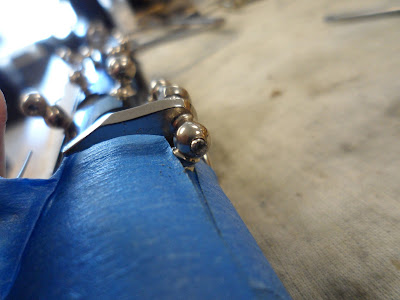To check for flatness, simply put a leak light inside (and turn it on), and put a perfectly flat tonehole file on it (abrasive side up, of course). Now you can see how flat the tonehole is.
I'm using the j.l.smith tonehole files, that are pretty special. They come with a giant delrin handle.
The allen wrench is inserted into the file like so (oh, and you can't see a small delrin guide that's under the file itself). Then I have to twist it until the tonehole is flat.
It will only make the tonehole flat, you need to be very very aggressive with the files to actually do any damage to it.
The tonehole is now flat, and needs to be de-burred. We use our solder scrapers gently and some of use use aluminum foil to polish it up too.
Just started padding. It's a giant nightmare. There's always light coming out, no matter what.
Now one of them is closer to being done (the one on the right if you can't tell).
Just a funky shot of pads in the air. Whoo!
Doing a small tonehole now (I forgot to do one)
And now it's flat!
Oboe time!
It looks so different from the clarinet!
Those are some weird keys with holes in the middle. To get that hole you have to use cork pads (also cork pads are used on the oboe because they give a perfect vacuum).
Some weird looking oboe keys laying around while I assemble the instrument again.
My screwboard. I have to say that the oboe is fairly complicated, compared to the instruments we've been working on so far.
The lower joint of the oboe (naked).
Keys of the lower joint hanging out, waiting to be put back on.
The oboe I had has had it's socket replaced. Just look at the colour of the plastic around the two toneholes to the right, and compare them to the one on the far left.
2nd of May was a snow day! so we didn't have school that day. I got to school at 6:30 to get some work done on my saxophone, but everything was locked. Bummer. The snow doesn't look that bad in this picture, but we had all that in just one night, and trees were breaking all over town, taking out power when falling on power lines.





















































